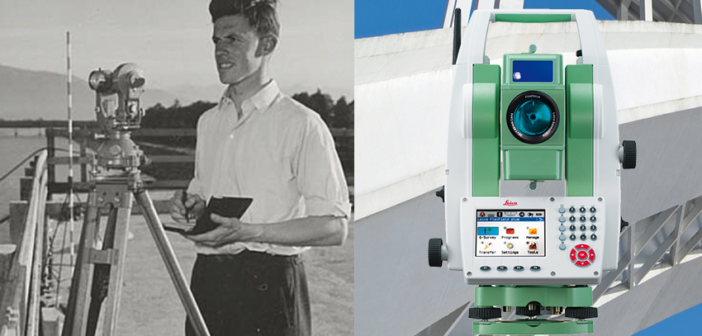The Wild T2 theodolite was a revolution in surveying. Heinrich Wild introduced it in 1921 and it was a success from the very beginning. With an angular accuracy of 1’’ the T2 was radical – lighter and smaller – than any instrument before. Wild Heerbrugg later became part of the Leica Group (read our history). From a technical point of view our actual solutions still have their roots in the Wild T2 theodolite. Our engineers continuously kept innovating and adapting it to customer’s needs until today – never forgetting Heinrich Wild’s core design principles.
This interview is the first of a series about modern manual total stations. Hans-Martin Zogg, Business Director for Total Stations at Leica Geosystems, compares the T2 with Leica’s actual manual total stations.

The Wild T2 theodolite in the field
What do the legendary Wild T2 and today’s manual total stations by Leica Geosystems have in common?
Straight to the point: Based on the T2, our manual total station solutions are still best in class. And believe me – here in Switzerland self-praising is not popular at all. Heinrich Wild managed to design the trust worthiest surveying instruments, which were easy to use in a wide area of applications, withstanding the harshest conditions on the planet: From Himalaya through the deserts of Peru to the humid rain forests of Indonesia. And this has not changed until today.
What is FlexLine and what makes it different to the Wild T2 theodolite?
Since Heinrich Wild’s achievements we continuously have launched innovations, which have disrupted surveyor’s work in a positive way. Think of all the electronics, that found their way into surveying, such as the Leica PinPoint distance measurement technology. Or the development of field software, like FlexField, or office software, like Infinity, optimizing workflows massively.

Setting the standard: Manual total stations FlexLine TS02plus, TS06plus, TS09plus by Leica Geosystems
Over the years these innovations lead to FlexLine, which today is one of our most successful product families. It consists of three premium quality manual total stations – the T02plus, the T06plus and the T09plus. All three are exceptional reliable surveying instruments. Reliability always was – and still is – crucial for the measurement professional.
What makes FlexLine so successful?
It is the measurement professional’s main pain points, which count. These are exactly met by FlexLine. Let me explain, how:
- Flexibility: Modern survey teams have to solve very different tasks from day to day, like cadastral work, setting-out and as-built measurements for tunnel or for building construction projects, to name just a few. With FlexLine total stations the surveyor gets the flexibility to use one instrument for all tasks. This gives the product family its name.
- Simplicity: Time pressure is every surveyor’s closest companion. Leica FlexField, the intuitive onboard software, with its user-friendly operator interface and guided workflows, speeds up work a lot. Newbies are motivated by the fast learning curve, whereas more experienced users estimate the quick navigation.
- Reliability and longevity: An instrument should do its work accurately – everyday. No matter, how weather or climate conditions are. For instance, I recently met customers in the Middle East. They work in the desert under extreme hot and humid conditions surrounded with very fine sand dust. They told me that the Leica FlexLine solutions “cost their money” but more important: They are the most cost-efficient. The design is extremely robust and they can always trust that the instruments do their work accurately.

Image 1: Testing under extreme conditions in the climate-chamber at -20 C° (-4°F) / Image 2: An instrument is carefully adjusted during production / Image 3: Testing laboratory
Would you hence say that it is no luxury to purchase Leica FlexLine equipment?
Referring to the old saying “bought cheaply will be paid dearly”. Customers tell us, that our instruments can be used over many, many years without technical problems or costly repairs. They say that higher initial costs clearly pay off typically in very short time. This and the benefits mentioned before lead to outstanding productivity. It is the utmost reason, why so many measurement professionals all over the world keep using Leica FlexLine instruments.
“We work in the deserts of the Middle East under extreme hot, humid conditions with very fine dust. Leica Flexline solutions cost their money but more important: Over the years they are the most reliable and cost-efficient. The design is extremely robust. We know we can trust that the instruments do their work accurately and reliably under these harsh conditions.”
Denis Meremans, Head of Survey Dpt at Six Construct Ltd., UAE
How Leica Geosystems reaches this exceptional high quality resulting into accuracy and robustness?
To begin with, we invest heavily in sophisticated production technologies. In addition, only the finest quality of raw materials is used in our total stations. We source our components from long-term partners who collaborate closely with us.
Decisions are taken with care, built on our longtime experience in research & development, production, quality control, customizing, and best-in-class service & support. You can feel this quality at the first touch.

Best-quality components delivered by long-term partners
Hans-Martin, thanks for this interview!
It was a pleasure to me.
Do you want to read more?
This interview is the first of a series giving insights on our manual total station solutions. Stay tuned for the upcoming parts 2 and 3 that will be released during the next weeks:
- Part 1:What do legendary Wild T2 and today’s Leica Geosystems’ manual total stations have in common?
- Part 2: Rise productivity with FlexField software
- Part 3: Get out more with the right dataflow















